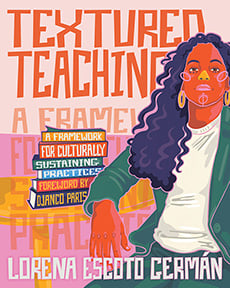
Editor's Note: This is part two of the Bias in Teaching series adapted from Textured Teaching by Lorena Germán. See part one here.
Schooling has a long and painful history in the United States, especially when considering marginalized groups. Marginalized refers to people who are left out of dominant culture and pushed to the margins, people who identify as something other than Christian, White, straight, cis-male, able-bodied, and more. For us, our presence and needs are seen as “other.” In identifying the original purpose of schooling in the United States, Paris and Alim highlight how the function of schooling was to force upon communities of color a dehumanizing assimilation through a “violent White imperialist project” (2017, 1). Because that is the foundation of schooling, and in many places this is still the underlying purpose of the structures in place, we need to name the injustices and the inequity in our schools and in our curricula. Textured Teaching is calling us to a radical stance: to love.
Why We Must Fight for Justice
I’ve heard questions about why as educators we must take on this fight for justice versus “just teaching” or solely focusing on content, as if there is such a thing. Every single content area is infused with bias and has been used in some way in the fabrication of the oppression of our country. If we all have bias through normal and common socialization, then why wouldn’t the content we have produced harbor it? We would be naive to think that we haven’t embedded it in to our educational system. Literature biases were infused and taught explicitly, which dehumanized people of color and marginalized any identity other than the dominant one. Science was used to justify and sustain racism. The project of White supremacy was born in the field of science. Mathematics was used to argue who was and was not a full human. (This is still an issue today regarding Indigenous identity and using DNA to justify someone’s heritage.) Geography was birthed as land was stolen and borders, like prisons, were created. History was written by the conquerors, who erased the rest of us. No content area is safe. No teacher is apolitical. If we don’t interrogate these histories and work toward teaching holistically, and more importantly, honestly, we are complicit. We are part of the violent White supremacist project and are implicated in the systems of oppression. As members of this racialized society, our imaginations are tainted. Implicit biases are present in our approach to school discipline and dress codes. What we think is possible for some is influenced by what we have seen and been told. What we think is reality is influenced by what has been constructed for us. We continue to infuse it into our students through our current approach to schooling. The very idea of racism stemmed from a person’s imagination. In perpetuating these ideas, we are also limiting our students’ imagination.
In what ways will our teaching influence the imagination of our students? How will we undo their racialized imagination and dismantle what has been constructed? Our imaginations are populated with histories of conquest, rape, theft, power, and dehumanization and its cousins. These antecedents shape how we read characters and how we write ideas. These ideas have been passed down to us from generation to generation. This is especially so when schooling has not offered us a counternarrative—one told from the point of view of the warrior; the ones that fought back. Students as early as preschool are developing racial identities and ideologies. By the time they are in middle school and high school, much socializing and learning needs to be undone. I’m hopeful because Textured Teaching can be one of the tools we use to undo this, to begin to make things right.
***
With Culturally Sustaining Practice as its foundation, Textured Teaching helps secondary teachers in any school setting stop wondering and guessing how to implement teaching and learning that leads to social justice. Lorena Germán shares her framework for creating a classroom environment that is highly rigorous and engaging, and that reflects the core traits of Textured Teaching: student-driven, community centered, interdisciplinary, experiential, and flexible. Throughout the book, she shares lesson design strategies that build traditional literacy skills while supporting students in developing their social justice skills at the same time. The actionable strategies used to bring Textured Teaching values to life illuminate what is possible when we welcome all types of texts, all types of voices, and all forms of expression into the classroom.
Related Reading

The following is excerpted from Textured Teaching: A Framework for Culturally Sustaining Practices by Lorena Escoto Germán.


